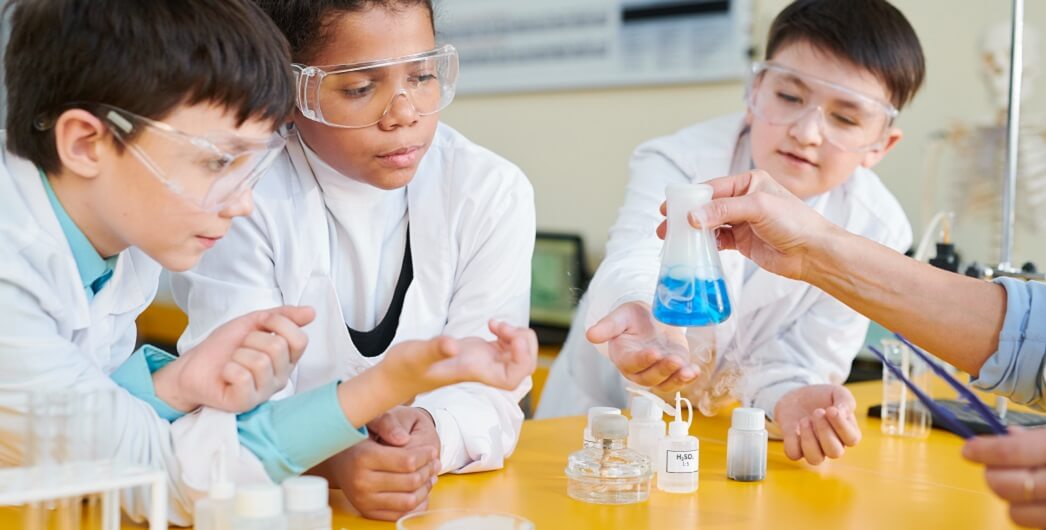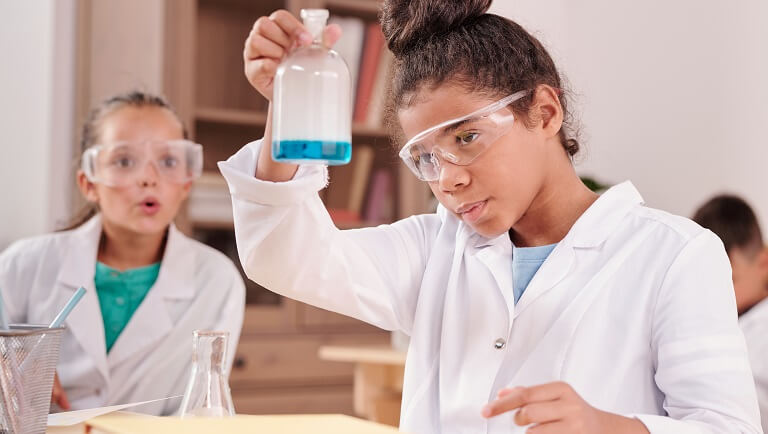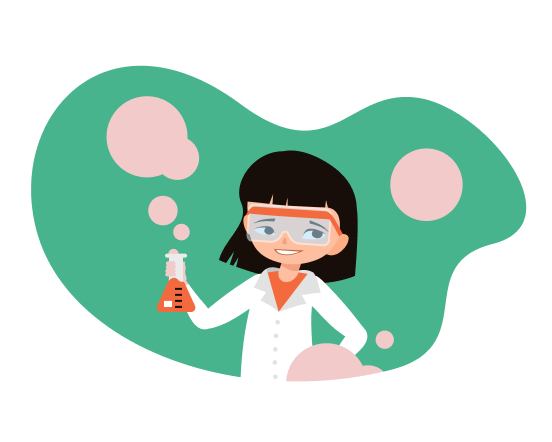
Chemistry for kids: chemical reactions
The first thing we need to understand before learning about the basics of chemical reactions is their definition. The easiest do it is to look at what is going on “inside” the reaction. Imagine that we have two different substances with their own number of atoms and the amount of mass, unique for each one. We decide to make them interact with each other and, as a result, we get at least one new substance. While the mass is conserved (it does not change), the atoms are getting rearranged; that is why the new substance gets new properties, different from the ones of an original substance.
Related:
- Science for kids: what are chemical elements?
- Atoms for kids: a simple explanation for those who have not yet studied chemistry in school
When we hear the words “chemical reaction”, we normally imagine something splashing and boiling, running through the bulbs and flasks, etc. However, most of the reactions can also be written down with the help of special equations. Scientists use symbols and formulas for elements and compounds. Thus, they can see the result without actually carrying out the experiment. For example, there is how we can write down the reaction between sodium and water:
2 Na + 2 H2O → 2 NaOH + H2
If we look at this equation attentively enough, we can see that the mass here is really conserved, and the atoms are combined in a different way — just like it would be seen in a real chemical experiment.
Where do chemical reactions take place?
Nonetheless, we can meet chemical reactions not only in the laboratory or in the students book in a written form, but also all around the world and even in our everyday life. For instance, your body carries out lots of chemical reactions simply while processing your food. As a result, the food is broken down into glucose and some other molecules that, furthermore, our cells absorb.
The next reaction releases energy from the molecules and, thus, we get energized and strong. By the way, the human body is not the only area where chemical reactions occur. One of the most significant reactions takes place in the plants and few microorganisms. It is called photosynthesis. This process is supposed to transform solar energy into the chemical energy of food. The product of photosynthesis is the main source of energy for living organisms on Earth. Some other reactions include such common activities as burning fuels, smelting iron, and baking bread. All in all, chemical reactions surround us everywhere, and it is almost impossible to overrate their significance.
How do chemical reactions occur?
But what exactly can play a role of a substance? They usually are chemical elements, molecules, and compounds. We also need to take in some more terms such as “reactant”, “reagent”, and “product”. What we call reactants and reagents are substances that we have from the very beginning. After their reaction, we get a product — the result formed by the interaction of the reactants. When carrying out a chemical reaction, we deal with the transfer, transformation, and conservation of energy.
The rate of chemical reactions
Chemical reactions differ not only by the type of reactants but also by the time it takes to get the final product. The “speed” of chemical reactions is called reaction rate. It can vary from rather slow (for example, metal rusting) to very fast (like an explosion). We can control and change the rate of some reactions by adding more heat, light, or electricity and increasing the reactants’ concentration. Moreover, some special substances (different for various reactions) enable us to speed up or slow down the reaction. The one that is called catalyst is responsible for increasing the rate of reaction, while an inhibitor can slow it down. They are normally not consumed by the reaction.
Types of chemical reactions
There are different types of chemical reactions, and they can be classified in various ways. The first way is to divide them according to the type of formed product. If we mix acid and base, we get salt and water — this is an example of an acid-base reaction.
Another way to distinguish between the chemical reactions is to classify them in terms of how the reaction proceeds. One of the easiest types is synthesis. It is a process in which two simple reactants are combined, and as a result, we get a new, more complicated product. It can be shown with a formula A + B → AB or a chemical equation of, for example:
2Na + Cl2 → 2NaCl
The reverse process is decomposition. It is a process where chemical compounds are broken down into simpler separate substances. This type of chemical reaction usually demands the input of energy. A formula for decomposition is AB → A+ B, and the example is a reaction with the solid potassium chlorate, which produces oxygen gas and the solid potassium chloride when interacting with heat:
2KClO3 → 2KCl + 3O2
There is another subtype of a decomposition reaction — electrolysis. In this case, we need water as a reactant and electrical energy to complete the reaction. It forms hydrogen and oxygen, which are the elements of a water molecule:
2H2O → 2H2 + O2
There is also such a type as a single displacement reaction (which can also be called a substitute reaction). It is a process in which a substance of one compound is taken by another one. The formula for this reaction is A + BC → AC + B.
Mg + Cu(NO3)2 → Mg(NO3)2 + Cu
We can go further and have a look at a double displacement reaction which is also called a metathesis reaction. Here we can witness not only one compound taking the substance, but both of them at the same time, which we see in the formula: AB + CD → AD + CB.
HCl + NaOH → NaCl + H2O
Besides, a photosynthesis reaction, which we already have mentioned, is an example of a photochemical type of reaction. That means it involves light photons.
An important division of the reactions is endothermic and exothermic types. This classification refers to the manner in which energy is transferred through the reaction. The endothermic reactions are the ones where energy is absorbed. It happens when we add energy to the process beforehand. The energy can be absorbed in the form of heat or electricity (as in the mentioned reaction of electrolysis). To illustrate the process of an endothermic reaction, we can apply heat to limestone at a high temperature and, thus, form the solid calcium oxide and release carbon dioxide gas.
On the other hand, there are exothermic reactions. Unlike the endothermic reactions, in this type, the energy is released. To make it clear, let’s look at the example. We have already said about the combustion of fuels: in this reaction, the energy is released as heat.
Anyways, there are lots of options on how to classify chemical reactions. For instance, synthesis reactions include an acid-base neutralization reaction, and combustion is a part of different decomposition reactions.
Difference between chemical reactions and physical changes

Another point to note is that we need to distinguish chemical reactions from physical changes. The main difference is that physical changes work with the states of matter — melting, evaporation, solidification, condensation, etc.
Physical changes do not deal with chemical identity, but, in contrast, they grant new properties to the substance. For example, physicians find it highly important if the water is frozen or not. However, it does not matter for chemists — the molecule still consists of two atoms of hydrogen and one atom of oxygen. In other words, if the state and the properties of the product were changed, it is a physical process. When we see that chemical bonds, compositions, and other parts of chemical identity were reformed, that means that a chemical change or reaction has occurred.
Evidence of a chemical reaction
However, it is not always obvious that the chemical reaction has really taken place. In this case, we can use specialized tests to ensure that we have got a positive result of the reaction. In other cases, we can evidence the products with our organs of perception. For example, when we mix gray iron and yellow sulfur and heat them, we get black iron sulfide. If we see this color at the end of the reaction, then we have done everything right. In our everyday life, we can meet a brownish metal oxide that is a result of metal corrosion.
Apart from the color, evidence of the chemical reaction can be a temperature change. The most obvious case is the type of reactions (such as an interaction between metal and oxygen) that produce a flame. Sometimes there can be only heat, without flames. For instance, the result of the reaction between water and calcium oxide is calcium hydroxide and a great deal of heat.
Another form of reaction evidence is the appearance of bubbles. That means some kind of gas has been produced. You have probably seen it while baking: cake batter rises when acid in the batter reacts with baking soda (sodium bicarbonate). What can also be evidence that a chemical change has occurred is a precipitate. This solid product is constructed as a result of a mix of certain liquids.
Fun facts about chemical reactions
Now, when you know what chemical reactions are, how they works, and what are the types of them, we provide you a little bonus — some bright facts about the reactions which will help you to memorize what you have just learned:
- From the chemical point of view, ice and water are the same substance even though they have different physical states. The molecule remains the same in both cases (H2O).
- Mixtures and solutions themselves are not chemical reactions as they do not provide the molecular change.
- A combustion chemical reaction is the basis of the car engine work.
- A chain reaction is a process when one reaction causes another and another, etc.
- The result of the reaction between liquid hydrogen and liquid oxygen can make the rocket go up!

new engaging articles



